Louvre / Prado
A walk through the Louvre and Prado museums is a full enjoyment for lovers of paintings. The Prado Pinacotheca and the Louvre Museum bring together a wide range of great works. All made by Grand Masters of the painting art from the 14th to the 18th centuries.
We will compare how different geniuses of the art of painting had to interpret the same stories.
Madrid Museum Tours will share with you impressions on this subject. We will base ourselves on a few paintings and omit some aspects already developed in the web pages of each museum.
Noli me Tangere
On the resurrection of Jesus and his encounter with Mary Magdalene.
Antonio Allegri ‘Correggio’’. Prado museum
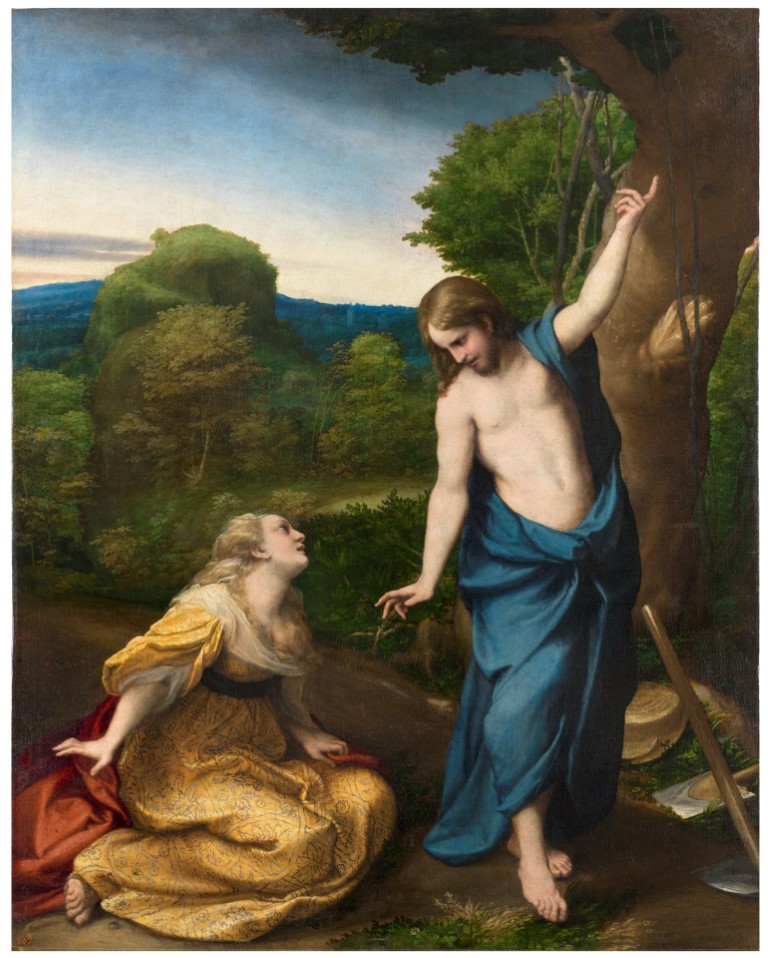
Correggio painted the encounter between Mary Magdalene and resurrected Christ. 7 years before Bronzino. Contrary to the representation of Bronzino, no other characters appear. The right hand of Mary Magdalene forms a diagonal with the raised left hand of Jesus. The right hand of the Savior traces a shorter diagonal with the left hand of the Magdalene. A third diagonal connects the glances of both protagonists.
The vertical composition produces a feeling of harmony and peace. The precious and meticulous landscape occupies most of the space. The vaporous sky of beautiful blue qualities reveals the dawn break. Correggio also did his best, painting the golden curls of blonde Mary Magdalene. Same with the transparent veil that covers her shoulders and the folds of her dress and mantle.
The center of interest of the painting is in the hands of Jesus Christ. They point to earth and heaven, respectively.
In short, Correggio achieves an academic composition that, at the same time, transmits spirituality.
El Bronzino. Louvre museum
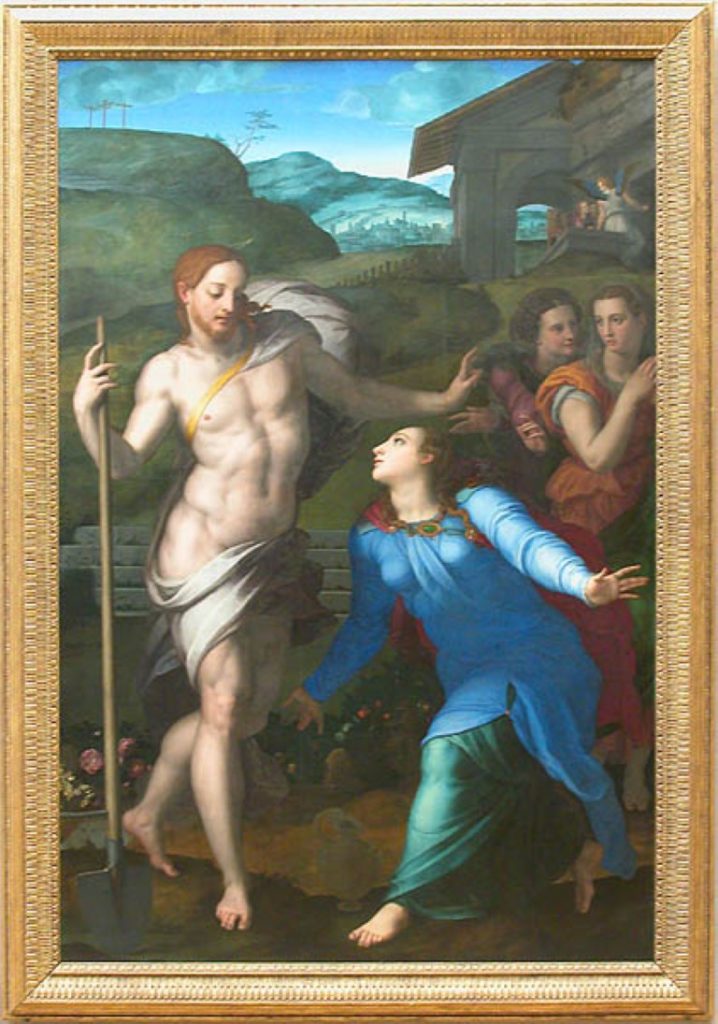
Bronzino stood out for its technical perfection. In spite of this, Bronzino’s religious paintings lack of emotiveness. His characters are not very expressive.
Christ slips away with a “mannerist feint” from Mary Magdalene’s embrace. The poor woman stays with her arms open. In the left background is the open tomb and an angel with Simon Peter and John.
In a more relevant background, to the left of the protagonists, Mary, mother of St. James and Juana run away. Part of Juana’s body is outside our field of vision. The skyline is above the head of Jesus. In the center of the bluish background, Jerusalem. In the distant right side , on a mound, the 3 crosses.
The composition has an ascending vertical structure, asymmetrical and, so, very dynamic.
The looks of Christ and Mary Magdalene cross in a direct diagonal. The observer enters into the painting through the robust body of Jesus Christ. The hands of Mary, St. James mother, are either out of place or belong to another character we do not see.
In short, Bronzino recreates resurrected Jesus and Mary Magdalene encounter according Mannerist canons. These canons prevail over the attainment of an atmosphere of religious spirituality.
David and Goliath
Caravaggio. Prado museum

Caravaggio painted this David and Goliath during the period of his life between the ages of 28 and 31. Two other David and Goliath came up later. One is in the Villa Borghese in Rome. The other, in the Kunsthistorisches Museum in Vienna. It’s a masterful composition . Caravaggio painted David crouched in a very small area. His body is larger than the surface of the canvas. In spite of it, the gravitation of the painting is optimal. The bent David occupies the middle and superior part of the surface of the picture. The decapitated giant lies in the inferior part, together with a piece of the sling and some stones. These last elements are the only ones that, part of it, are not within the whole field of vision of the viewer. David is tying Goliath’s curls with a rope to pull his enormous head down into the valley, where his people are waiting for him. A shade darkens his face, his gaze is sad. A warm halo of direct light focuses some corporal parts of both characters. Others remain darkened. A David of dirty toes and a beheaded Goliath who follow us wherever we go. It’s a masterpiece of chiaroscuro, full of dark and deep emotions.
Guido Reni. Louvre museum
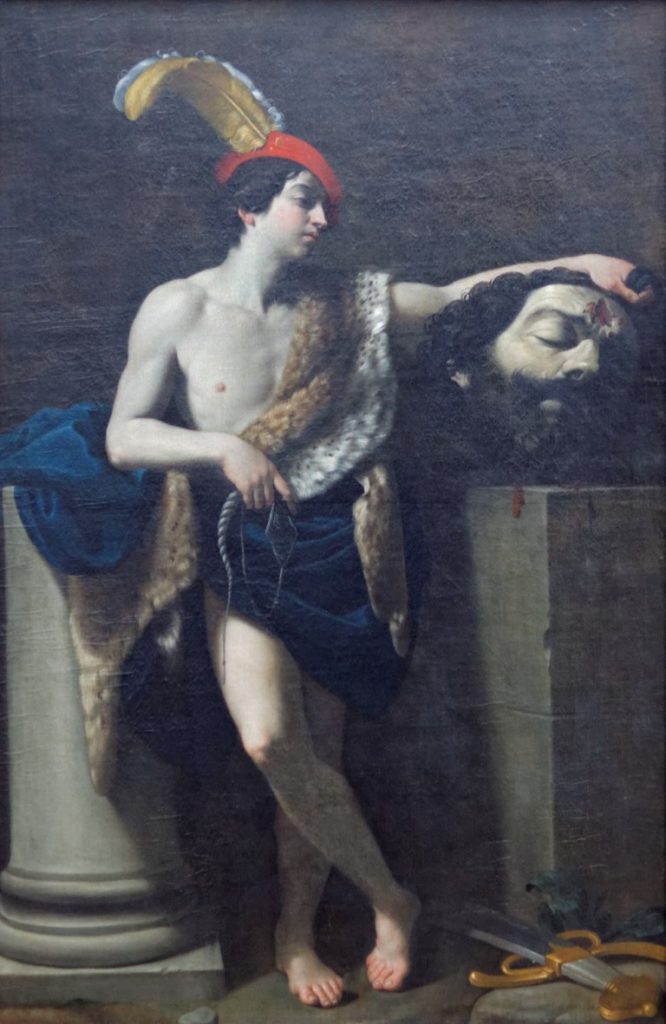 Guido Reni represented an androgynous David in a feathered cap contemplating decapitated Goliath. The giant’s head, with closed eyes, turns towards the opposite side of his executioner.
Guido Reni represented an androgynous David in a feathered cap contemplating decapitated Goliath. The giant’s head, with closed eyes, turns towards the opposite side of his executioner.
Reni was 30 years old when he painted this vertical composition. He applied Caravaggio’s chiaroscuro, but without the tension and dynamism of his works. A calm atmosphere surrounds the characters. A reflective David grabs the giant’s head with his left hand while he contemplates it. Guido Reni refrains from showing a triumphant David. (Such as Poussin’s or Strozzi’s David). The delicate and victorious David rests his right elbow on a smooth cut column. He emulates the Hellenistic sculptures that Anibale Carracci, Reni’s master, exalted in paintings.
No doubt that this soft David is the center of attraction of the work. His pink cheeks and semi-discovered torso probe Reni’s skills creating beautiful men. ( Check Reni’s Saint Sebastian, Hipomenes or Saint John the Baptist). David’s hands and crossed feet are other proofs of virtuosity.
Sadly, the shady parts of the painting lack of the textures and qualities of good Tenebrist works.
Hercules and the Hydra of Lerna.
Guido Reni. Louvre museum

Guide Reni refused for several years to attend the invitation of Fernando I of Gonzaga. The Duke of Mantua wanted Reni to paint some frescoes for his Ducal Palace. Reni finally accepted the execution of a series of 4 large paintings on the Works of Hercules. (Today, all displayed at the Louvre). Hercules and the Hydra of Lerna is the only one faithful to the 12 works of the powerful, incorrupt mythological hero.
The deadlines for the Works of Hercules got delayed by the Duke’s insolvency and Reni’s compulsive gambling. The artist needed funds, which the Duke was not in a position to provide, to please his compulsion,
Reni exhibits here the academic technique he assimilated from Anibale Carracci. We see a vigorous Hercules, full of movement, in a close-up that impels him almost out of the canvas. The hero looks bored, tired, with his gaze grieved. Despite all the blows he inflicts on the hydra, its heads keep tripling.
The mediocre painted scenery is due to Reni’s little motivation during his stay at the Palace. He was at the mercy of a lousy paying client and contracting huge gambling debts. Anyway, the powerful Hercules is the center of interest of the painting.
I loved Reni’s Hercules at the Louvre. The compositions differ from the delicate works we can enjoy from this great artist in the Prado museum.
Finally, although I should not compare, Reni’s hero is ‘sexier’ than those Hercules of Rubens‘ and Zurbaran you can see in Madrid’s best pynacotheque.
Zurbaran. Prado museum

17 years after Reni accepted the Duke’s commission to paint some Hercules works, Zurbarán took on a similar undertaking. The decoration of the windows of the Great Hall of the Buen Retiro Palace. He delivered a serie of 10 canvases. Hercules was the hero of Charles V, Emperor and first Austrian King of Spain. Zurbaran’s paintings thus have an allegorical content, referred to the Austrian Spanish monarchy.
Hercules and the Hydra of Lerma is my favorite of all the series. The composition consists of 4 characters in struggle. On the side of the monsters the hydra and a crab upside down that pricks the right foot of Hercules. The hero, for his part, has the help of his nephew Iolao. He appears half-bodied at the entrance of the hydra’s burrow. Iolao carries the final weapon that will destroy the monster : Fire. A Hercules beating the hydra occupies the central and most striking part of the work. His appearance is fearsome and his gaze reveals decision. It is scarier than the hydra, which resembles a frightened pet. In fact, some of the monster’s heads show an expression of authentic panic. Especially the one that is in the front and that nails its eyes in the burning torch that holds Iolao. The soft Zurbaran’s chiaroscuro spreads in the characters and the monsters cave.
A parenthesis to go to the contemplative monks of Zurbaran, for sure his masterpieces. Everybody admires Zurbaran’s skills to reflect in his contemplative monks wonderful expressions of introspection, mysticism, asceticism, concentration… That refined technique exhibited in the monks’ white robes, prodigious folds, perfect drawn hands.
None of these strong aesthetic points developed Zurbaran in the Works of Hercules. The anatomy of the hero is roughly sketched. His suntanned face resembles that of a farmer working in the fields from sun to sun. Hercules hasn’t the body of a warrior, but of a strong dock loader.
With 4 vessels, Zurbaran made the perfect Spanish still life. In spite of its imperfect illumination. With his imperfect mythological hero, though, the artist created a very much Spanish looking Hercules. The most Spanish of all.
The Crucifixion
Andrea Mantegna . Louvre museum

During my tour of the Louvre, the Crucifixion by Andrea Mantegna stand out in a preferred place. Painted between 1456 and 1459 and based on the Gospel of St. John.
The composition is symmetrical and linear. The center of the painting is in the crossed feet of Jesus. A diagonal crosses the rocky summit of the Golgotha, where Adam, the First Man, was created and buried. The horizon line coincides with the center of the picture. The vanishing point, above the head of Christ. The horizon line determines a point of sight at the same height as the scene
On both sides of the Lord are the crosses of the good and the bad thief. Both turned slightly towards the central cross. Let’s imagine an equilateral triangle from the base of the 2 lateral crosses. Its top crosses in the ”INRI” banner over Jesus head. At the same time, let’s draw in our imagination an inverse equilateral triangle, which base line is at the cusp of the lateral crosses. Its lower vertex ends at the skull, at the foot of the cross of Christ.
On the right side of Jesus Christ there is the good thief. In the foreground, John, the beloved disciple, in a semi-profile position. His disconsolate gaze centers on the bloodless head of the Savior. Behind him, broken skeletons emerge from a grotto. The mother of Christ arrives at the place, bent in pain, supported by her sister. Mary Magdalene, in blue and yellow, adopts a posture of resigned sorrow. On the hillside, some riders return to a walled and meticulously drawn Jerusalem.
On the left side of Jesus Christ Mantegna depicted a darkened bad thief. Some Roman soldiers are circumventing the pink robe of Jesus. Behind and in front of the evil thief’s cross are 2 Roman riders. The one in the foreground is also in semi-profile, but it turns its back more to the spectator. If we compare this rider with John, on the opposite side, we identify a lack of perspective between the two. Unless John is a giant or the Roman rides a pony. Neither perspective was perfect nor did Mantegna shined with the drawing of some distant clouds.
I change of subject because I am looking with these critics for trouble where there is none. Back to the good things.
I loved the rich textures of the blue sky. Getting darker from the bottom to the top. Also the rich expressions of the faces and the masterful drawing. And I remained absorbed for a long time by the beauty of the colors.
Last but not least : Let’s draw finally an invisible oval to frame the scene of the Crucifixion. The line of the major axis passes through the feet of Jesus Christ. The minor axis go through the center of his cross. It will turn out that the oval will include all the characters, good and bad. What a beautiful allegory about God’s Love, which encompasses both. The virtuous ones and the sinners.
Juan de Flandes. Prado museum
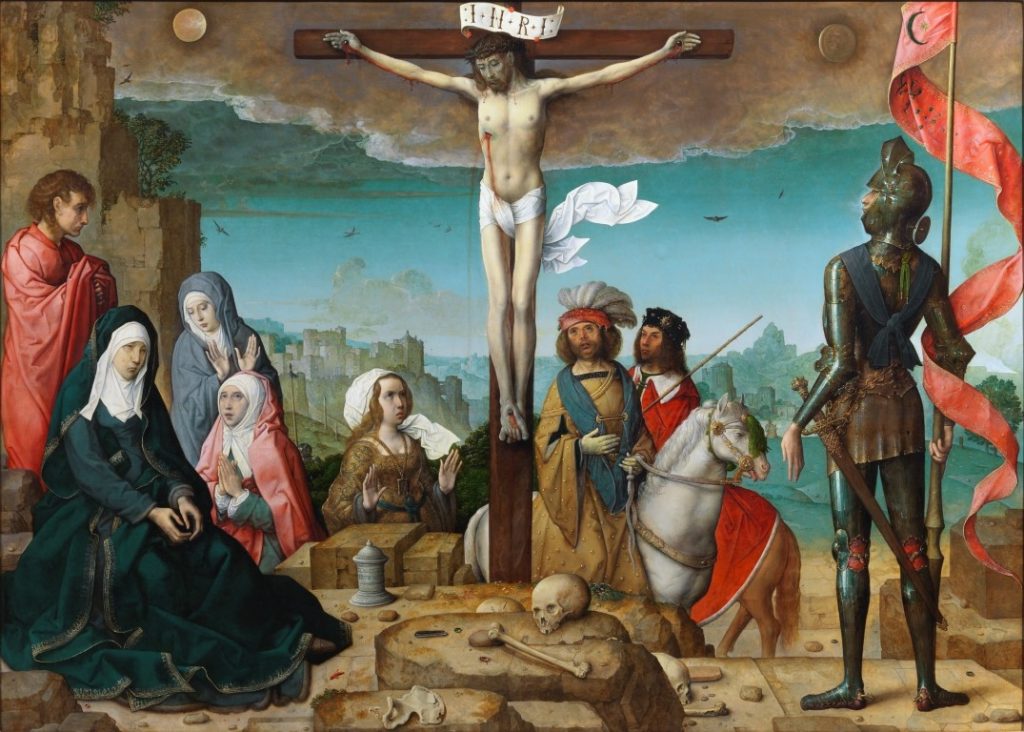
The Flemish artist Juan de Flandes painted in 1519 the Crucifixion. Its first location was at the main altarpiece of the Cathedral of Palencia. The work respects the iconographic canons in force in the Quattrocento. It presents a deceased Christ. The ”bad guys” have left. To his right, Juan, María, the two Marías and María Magdalena watch over him. John’s gaze encompasses the space between him and the white canvas that covers Jesus. A strong wind shakes the cloth behind the cross. The mother of Christ fixes her eyes on the skull at the foot of the cross. The attention of the Flemish armored Roman officer, in the left corner of Jesus, focuses on his bowed head.
All Maries, except the Magdalena, choose not to direct their eyes on the cross. In reality, all mourners look for different points. The hands of the characters express their individual state of mind. Resignation, pain, devotion, rejection and respect. Above the cross an impressive painted cloud has certified the death of Christ.
It is a linear composition of static characters. The clothes and folds reveal the virtuosity of the Flemish School. This comes out in the skills of Juan de Flandes to paint the landscape in the background.
And Jerusalem, Golgotha and the vessel, bones and stones scattered on the paving.
For me, the best : The dignity of the characters to bear pain, without exaggerated attitudes.
Nudes

Goya and his naked Maja . Prado museum Ingres and his Great Odalisque. Louvre museum
Are the nudes painted by Goya and Ingres beautiful? It’s a difficult question to answer, like when Socrates asked Hipias, “What is beauty?”
Goya’s got the commission of a female nude portrait by prime minister Manuel Godoy. Queen Carolina Murat, Napoleon’s sister, requested Ingres the Grand Odalisque.
Both, Godoy and Murat, did not miss the opportunity to show galant nudes to their friends. It is easy to deduce that both personalities liked the portraits very much.
But are these nudes beautiful? Any specialist in female anatomy will appreciate that both nudes are imperfect. But from an artistic point of view, the two works produces pleasant sensations. The 2 nude portrayed ladies attract the observer with their gaze. Their horizontal body is well placed in the picture and promising provocative. Yet, the asymmetry of the model’s position in the canvas gives them a lively dynamism. In fact, they are not ”nude sculptures”. The soft shades of chiaroscuro through skins and environments create an intimate atmosphere.
Back to the anatomical criteria, it is clear that Goya mastered nudes better than Ingres. The odalisque’s hands and feet look like rubber. Her butt is too voluminous. She twists her neck in an impossible manner.
Goya’s portrayed a perfect female body, from head to toe. Good work, considering that Goya did not seem to like her. She had a shameless and selfish personality. Attributes that stand out immediately to the public who watch the painting.
Let us finally answer the question at the beginning.
The physical beauty that we first bestowed on the odalisque fades as we analyzes her.
The nude made by Goya causes a more lasting well-being. It passes with excellence an anatomical and artistic examination. But her unpleasant character makes the well informed viewer not to like her. This shows how important it is to know the secrets of paintings for judging whether a work is beautiful. The analysis of a work of art can’t begin and end in a superficial external inspection.
My opinion is that the nudes in question are not beautiful.
And you, patient reader ( above all, patient ) what do you think ?

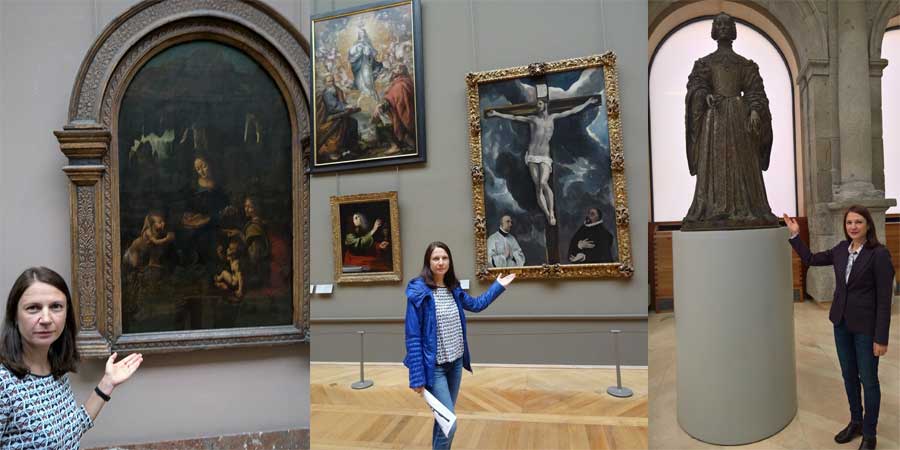
Recent comments